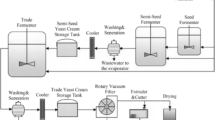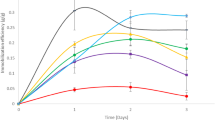Abstract
In the Melle-Boinot process for alcohol production, centrifuges are normally used for yeast recovery at the end of a batch fermentation. Centrifuges are expensive equipment and represent an impressive part of the equipment costs in alcohol industries. In the present work, an alternative method for yeast recovery using less expensive equipment was studied. Instead of using centrifuges, yeast was separated from the fermented broth by filter aid filtration, followed by separation of yeast from the filter aid using hydrocyclones. A stainless steel plate-and-frame filter of filtration area 1.14 m2 and two 30 mm hydrocyclones, which followed the Bradley and Rietema recommended proportions, were used in this work. The filter aid was perlite. Tests of direct separation of yeast from the fermented broth using the Bradley hydrocyclone proved to be completely unfeasible, since the maximal reduced total efficiency obtained was only 1%. When the hydrocyclones were used to separate perlite from the resuspended filtration cake, the perlite total separation efficiency obtained in the underflow was as high as 95% when using the Bradley hydrocyclone with an underflow diameter of 3 mm. To show the feasibility of the proposed new method of yeast recovery, a complete cycle of experiments, which included fermentation, yeast separation, and new fermentation using the recycled cells, was performed with good results.
Similar content being viewed by others
References
Antunes M and Medronho RA (1992) Bradley hydrocyclones: design and performance analysis. In: Svarovsky L & Thew MT (eds.) Hydrocyclones: Analysis and Applications (pp. 3-13), Kluwer Academic Publishers, Dordrecht, The Netherlands.
Bendixen B and Rickwood D (1994) Effects of hydrocyclones on the integrity of animal and microbial cells. Bioseparation 4: 21-27.
Bradley D (1965) The Hydrocyclone. Pergamon Press, Oxford.
Castilho LR and Medronho RA (2000) A simple procedure for design and performance prediction of Bradley and Rietema hydrocyclones. Minerals Engineering. (In press).
Cilliers JJ and Harrison STL (1996) The effect of viscosity on the recovery and concentration of micro-organisms using mini-hydrocyclones. In: Claxton D, Svarovsky L and Thew M (eds.) Hydrocyclones'96 (pp. 123-133). Mechanical Engineering Publications, London and Bury Saint Edmunds.
Cilliers JJ and Harrison STL (1997) The application of mini-hydrocyclones in the concentration of yeast suspensions. Chem. Eng. J. 65: 21-26.
Gong CS, Cao NJ, Du J and Tsao GT (1999) Ethanol production from renewable resources. In: Scheper T (ed.) Advances in Biochemical Engineering/Biotechnology. Vol. 65 (pp. 207-241). Springer, Berlin.
Harrison STL, Davies GM, Scholtz NJ and Cilliers JJ (1994) The recovery and dewatering of microbial suspensions using hydrocyclones. In: Pyle DL (ed.) Separations for Biotechnology. Vol. 3 (pp. 214-220). SCI, The Royal Society of Chemistry, Cambridge.
Heiskanen K (1993) Particle Classification. Chapman & Hall, London.
Ho NWY, Chen Z, Brainard AP and Sedlak M (1999) Successful design and development of genetically engineered Saccharomyces cerevisiae yeasts for effective cofermentation of glucose and xylose from cellulosic biomass to fuel ethanol. In: Scheper T (ed.) Advances in Biochemical Engineering/Biotechnology. Vol. 65 (pp. 163-192) Springer, Berlin.
Jones RP, Pamment N and Greenfiel PF (1981) Alcohol fermentation by yeast — the effect of environmental and other variables. Process Biochemistry 15 (April/May): 42-49.
Klima MS and Kim BH (1998) Dense-medium separation of heavy-metal particles from soil using a wide-angle hydrocyclone. J. Environ. Science and Health, Part A. 33: 1325-1340.
Marti S, Erdal FM, Shoham O, Shirazi S and Kouba GE (1996) Analysis of gas carry-under in gas-liquid cylindrical cyclones. In: Claxton D, Svarovsky L & Thew M (eds.) Hydrocyclones'96 (pp. 399-421). Mechanical Engineering Publications, London & Bury Saint Edmunds.
Medronho RA (1984) Scale-Up of Hydrocyclones at Low Feed Concentrations. Ph.D. Thesis, University of Bradford, United Kingdom.
Moraes CAC, Hackenberg CM, Russo C and Medronho RA (1996) Theoretical analysis of oily water hydrocyclones. In: Claxton D, Svarovsky L & Thew M (eds.) Hydrocyclones'96 (pp. 383-398). Mechanical Engineering Publications, London & Bury Saint Edmunds.
Plitt LR (1976) A mathematical model of the hydrocyclone classifier. CIM Bulletin 69 (Dec.): 114-123.
Rickwood D, Freeman GJ and McKechnie M (1996) An assessment of hydrocyclones for recycling kieselguhr used for filters in the brewing industry. In: Claxton D, Svarovsky L & Thew M (eds.) Hydrocyclones'96 (pp. 161-172) Mechanical Engineering Publications, London & Bury Saint Edmunds.
Rickwood D, Onions J, Bendixen B and Smyth, I (1992) Prospects for the use of hydrocyclones for biological separations. In: Svarovsky L & Thew MT (eds.) Hydrocyclones: Analysis and Applications. (pp. 109-119) Kluwer Academic Publishers, Dordrecht, The Netherlands.
Rietema K (1961) Performance and design of hydrocyclones. Parts I to IV. Chem. Eng. Sci. 15: 298-325.
Rosin P and Rammler E (1933) The laws governing the fineness of powdered coal. J. Institute of Coal 7: 29-36. Discussion, ibid.: 109–112.
Smith GRS (1990) Filter aids. In Svarovsky L (ed.) Solid-Liquid Separation, 3rd Edn. (pp. 338-357). Butterworths, London.
Svarovsky L (1984) Hydrocyclones. Holt, Rinehart and Winston, London.
Svarovsky L (ed.) (1990) Solid-Liquid Separation, 3rd Edn. Butterworths, London.
Yuan H, Rickwood D, Smyth IC and Thew MT (1996a) An investigation into the possible use of hydrocyclones for the removal of yeast from beer. Bioseparation 6: 159-163.
Yuan H, Thew MT and Rickwood D (1996b) Separation of yeast with hydrocyclones. In: Claxton D, Svarovsky, L & Thew, M (eds.) Hydrocyclones'96 (pp. 135-149) Mechanical Engineering Publications, London & Bury Saint Edmunds.
Author information
Authors and Affiliations
Rights and permissions
About this article
Cite this article
Martins da Matta, V., de Andrade Medronho, R. A new method for yeast recovery in batch ethanol fermentations: Filter aid filtration followed by separation of yeast from filter aid using hydrocyclones. Bioseparation 9, 43–53 (2000). https://doi.org/10.1023/A:1008145419175
Issue Date:
DOI: https://doi.org/10.1023/A:1008145419175




